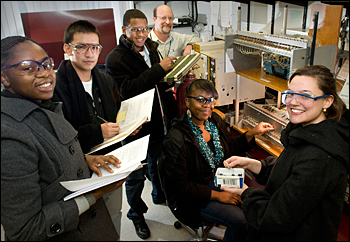College Mini-Semester Students Explore Science & Technology at Brookhaven Lab
January 14, 2010
 enlarge
enlarge
Preparing perfluorocarbon samples for analysis are College Mini-Semester students (seated) Kadiah Kamara from Syracuse University (and clockwise, from right) Kristen Constantine, Immaculata University; Senge Ngalame, Talladega College; Jimmy Rodriguez, New Jersey Institute of Technology; Ahmed Barry, Borough of Manhattan Community College, and Brookhaven National Laboratorys Richard Wilke, who is supervising the students laboratory work.
UPTON, NY — Twenty-three students from 22 colleges — from New York and locations as far-ranging as Alabama and Kentucky — learned about world-class science and technological achievements at the U.S. Department of Energy’s Brookhaven National Laboratory during five activity-packed days of their winter break. The students were enrolled in the Laboratory’s Mini-Semester Program, which aims to expose interested students to cutting-edge science through lectures, tours, and team research.
The students toured the National Synchrotron Light Source, where researchers probe materials as diverse as computer chips and viruses, and the Center for Functional Nanomaterials, where scientists study materials on the scale of a billionth of a meter with the primary goal of finding alternatives to fossil fuels. Also, they learned about research at the Relativistic Heavy Ion Collider, where physicists discovered a “perfect” liquid that they believe existed in the early universe.
“The Mini-Semester program is intense and challenging, and we introduce the students to as many areas of science as possible,” said Noel Blackburn, an educational programs administrator in Brookhaven’s Office of Educational Programs. “All of the students are science, technology, engineering or mathematics majors, and many of them go on to attend our summer internship programs.”
The students assisted in a study of indoor air quality in the Laboratory’s Research Support Building (RSB), a three-year-old LEED-certified building, which houses a staff of 170 and has numerous visitors. The students took samples of perfluorocarbon (PFT) tracers in the RSB and analyzed them to determine air ventilation parameters in the building. The harmless gas tracers have been used in field studies for more than 30 years.
The students’ analysis, together with a similar study conducted by Brookhaven scientists last fall, will be used to improve airflow models for modern, atrium-style buildings, information that will help first responders in the event of an accidental or intentional release of hazardous substances. The data will also help improve energy efficiency as well as assist Lab staff in determining the best locations for outdoor smoking areas in order to keep passive smoke from entering the building.
“The students used a gas chromatograph to analyze samples,” said John Heiser, a senior environmental research engineer at Brookhaven who supervised the students’ participation in the air-quality study. “Although we found a high concentration of PFTs that indicated cigarette smoke from outdoor smokers was entering the building, the 2009 data were inconclusive because they were taken from a 24-hour integrated sample. We’re taking hourly samples now, rather than averaging samples taken at night, to be sure the first results were not due to a nighttime air inversion in which the temperature at the ground stays warmer, allowing smoke to linger longer.”
All of the students are eligible to return to Brookhaven to participate in the Department of Energy’s summer internship programs managed by the Office of Educational Programs. On February 1, Brookhaven’s scientific community will start their selection of interns for the summer programs.
2010-11064 | INT/EXT | Newsroom









